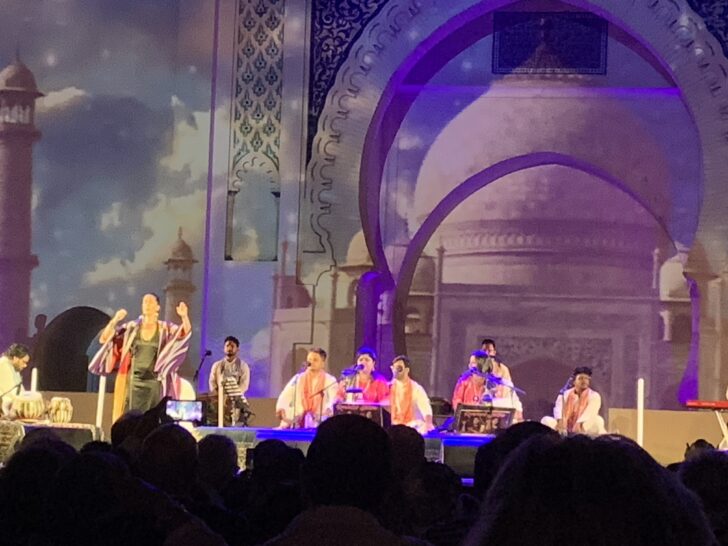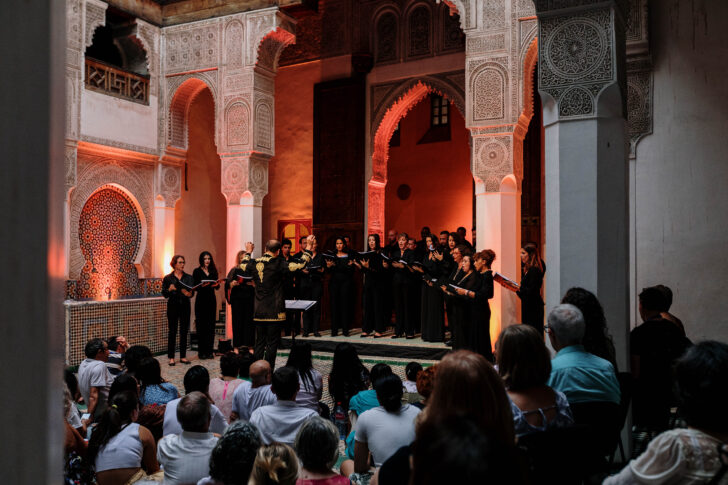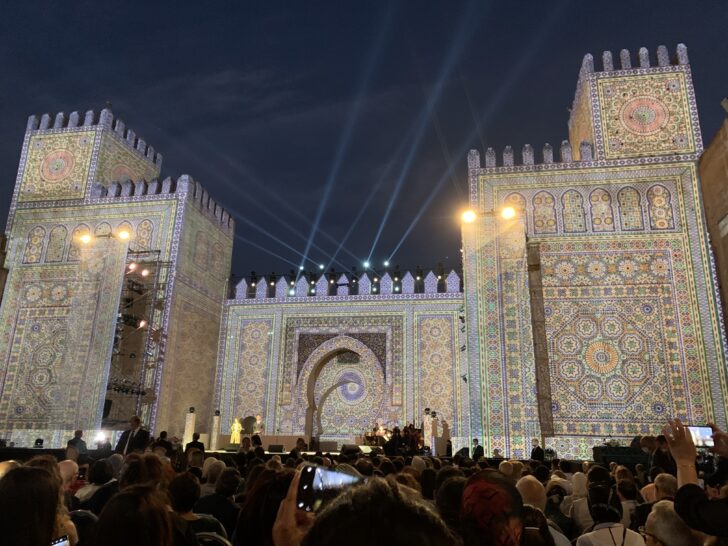More details
Morocco – Fez. 09/12-VI-2022. World Sacred Music Festival. Various ensembles from all over the world, and works of sacred and traditional music from more than 15 different countries. Bruno Messina, artistic direction
After two years of interruption, the Fez Festival of Sacred Music of the World has reinvested the spiritual capital of Morocco, bringing together artists from all over representing the five major religions of the world, in their musical expressions, but also architectural. This 26th edition was the first for Bruno Messina, its new artistic director.
Appointed artistic director in 2019, drawing on his experience and talent as a programmer at the head of the Berlioz Festival and the Messiaen Festival, Bruno Messina, son of an Andalusian mother from Casablanca and a Sicilian father from Tunis, has also strong ties with the country.
It’s a tour de force. At the end of February, the uncertainty linked to the pandemic context was still paralyzing everything in Morocco, and the Fez Festival was (im) patiently awaiting the hour of its reunion with its public and with the many artists who converge there from all walks of life. And then the bright spot: the lifting of health constraints and the reopening of borders and airways, enabled the organizers to take up this crazy challenge of mounting this international event in three months, bringing together 120 musicians from more than 15 countries.
Shaped by its plural identity, rich in the diversity of its cultural heritage, Morocco, “one of the oldest kingdoms in the world” as Abderrafia Zouitene likes to point out, the President of the Esprit de Fès Foundation, which carries the festival, is committed to its values of tolerance, peace and openness. Under the High Patronage of King Mohammed VI, the festival aims to be imbued with this unifying spirit, recognized by UNESCO, which in 2018 established a partnership with the Foundation. The theme chosen this year under the title “Architecture and the Sacred”, developed during the forum devoted to it, placed the program as a whole under a particularly open and rich angle, highlighting the close links between architecture and music, music inscribing in time what architecture inscribes in space », says Bruno Messina in his editorial. She has covered centuries of history and the entire planet, tracing bridges between the materiality of the heritage built since antiquity and the equally ancestral musical heritage, revealing their immaterial, spiritual dimension, proportion, geometry, harmony, ornament at the service of aesthetics and elevation of the spirit being their common denominators.
It is in the heart of this city founded in the eighth century by Idris 1st, which conceals a number of treasures behind its ramparts and in the shade of its medina – mosques, medersas, ryads, palaces, synagogues… encrusted like jewels in the spaces where daily life takes place – where the festival takes place. Fassi or traveller, Moroccan or foreigner, the festival-goer is invited to four of its emblematic places. If he chooses to immerse himself in the thirteen events offered over four days, it is a journey from North Africa to Central Asia and a real initiatory journey that awaits him.

Sacred marriage of architecture and music at Bab Al Makina
The first highlight of the festival is at Bab Al Makina, a monumental gate built in 1886 at the junction of the old medina and the new town, which dominates a huge square surrounded by walls. At nightfall, nine companies come together to give a dazzling and grandiose spectacle at the foot of the high wall, while images of the high places of spirituality in the world are projected there in a giant mapping designed by Alain Weber. Hebrew songs and Sufi poetry for a journey through the Judeo-Arab and Berber history of Morocco, vertical dance on a background of European music, Tibetan bard accompanied by his dranyen (lute) proclaiming and chanting the Praises of the poet Milarepa, joined by the guembri (Moroccan instrument) by Aziz Erradi, the deserts of the Himalayas and the Sahara combined, Kathak dance and Qawali songs from India, Persian sung poetry, the Sama choir from Fez dazzle the ears as much as the eyes, captivated by the views of Jerusalem and its synagogues, Notre-Dame de Paris cathedral, the Taj Mahal and the great Hassan II Mosque in Casablanca. A vocabulary of vaults and domes, rose windows, stained glass windows and zelliges which dialogue just like this music in harmonious and astonishing correspondences, intimately linking the most distant expressions, revealing their meeting points.
Jewish songs at the Aben Danan Synagogue
A poignant moment the next day at the Aben Danan Synagogue, a discreet 12th-century gem nestled in old Fez. Pianist and composer Michael Lévinas returned to the land trodden in his childhood with his father, accompanied on the piano by soprano Marion Grange in Espenbaumand Die Schleusetwo melodies to poems by Paul Celan from his oratorio la Passion according to Saint Mark-A Passion after Auschwitzand three other songs: a song taken from the Symphony No. 1 by Mahler, a 19th century Yiddish song, and Kaddish by Ravel. How not to be shaken by the voice of Marion Grange, by the accents of this music which mixes tremors, cries, complaints, prayers and despair… A concert which left neither indifferent nor unscathed!
In the vast Jnan Sbil Garden created in the 18th century, the shade of orange trees and eucalyptus is precious when the heat is at its peak. It is five o’clock and the call to prayer resounds. The concert can begin. There are three here: the Al Zawya ensemble celebrates with one voice gratitude, love and peace through the spiritual songs of the Sultanate of Oman. Combining tradition and modernity, Corsican polyphonies and oriental repertoire, the A Filetta ensemble offers a sung encounter with the Egyptian slammer Abdullah Minlawy, the Lebanese singer Fadia Tomb el Hage and the saxophonist Peter Coser, “embracing all the Mediterraneans” in the Corsican languages , Arabic and Syriac. Simon-Pierre Bestion’s company La Tempête gives its magnificent program “From Fez to Jerusalem” (created at the Saint-Denis festival and at the Cité de la Voix in Vézelay), combining classical music (from Pierre le Vénérable to Arvo Pärt via Schütz, Rachmaninov…), and traditional songs from the Orient: prayers, lullabies, dances, love songs from the distant past to today, sung in twelve languages.
More intimate, the Dar Adiyel Palace built at the beginning of the 18th century and now housing the Conservatory of Traditional Music is a perfect place to listen, seated on large carpets, to the sweet voice of the Senegalese Senny Camara accompanied by her kora. A moment of grace, poetry, simplicity, listening to his songs of healing, enveloping, caressing. An endearing artist singing “I am because you are”… Rougher and stronger, the Sardinian polyphonies sung by the group Tenores Gòine make the same place vibrate with their captivating traditional songs. We also discover the muqam, an accompanied, refined and joyful song, born of a 15th century Uighur tradition strongly influenced by Islam, by the Sanyie Ismail ensemble from Central Asia.
 Discovered by Bruno Messina while performing at the 100th anniversary of St-Pierre Cathedral in Rabat, the Moroccan Chamber Choir was created less than a year ago in Casablanca, on the initiative of its conductor Amine Hadef, singer trained in France at the mastery of Notre-Dame de Paris and with the best musicians (Nicole Corti, Laurence Équilbey, Hervé Niquet, Philippe Herreweghe). Composed of 25 singers from various backgrounds, Moroccan but also French and sub-Saharan, the choir offers a set of works a cappella of Brückner, Mendelssohn, as well as the Miserere of Allegri. We can appreciate the fervor and measure the path traveled by this still novice choir, which nourishes ambitious projects: Amine Hadef wants to continue the vocal work initiated, and move towards the creation of a “new baroque” with the addition of a Moroccan instrumental ensemble for the interpretation of Cantatas by Bach and Motets by Schütz.
Discovered by Bruno Messina while performing at the 100th anniversary of St-Pierre Cathedral in Rabat, the Moroccan Chamber Choir was created less than a year ago in Casablanca, on the initiative of its conductor Amine Hadef, singer trained in France at the mastery of Notre-Dame de Paris and with the best musicians (Nicole Corti, Laurence Équilbey, Hervé Niquet, Philippe Herreweghe). Composed of 25 singers from various backgrounds, Moroccan but also French and sub-Saharan, the choir offers a set of works a cappella of Brückner, Mendelssohn, as well as the Miserere of Allegri. We can appreciate the fervor and measure the path traveled by this still novice choir, which nourishes ambitious projects: Amine Hadef wants to continue the vocal work initiated, and move towards the creation of a “new baroque” with the addition of a Moroccan instrumental ensemble for the interpretation of Cantatas by Bach and Motets by Schütz.
As on the first evening, the public flocks to Bab Al Makina, to hear again the Roohani Sisters, from North India, sing and improvise on Sufi music with solar virtuosity and contagious passion, carrying in their musical wake a great Iranian voice, that of Ariana Vafadori. But it is with the bubbling Ibrahim Maalouf, accomplice of the gleaming brass band Haïdouti Orkestar and his musicians from all over the world, that this great celebration of the sacred finds its full festive dimension. The festival ends in the Arab-Andalusian tradition, in the company of the Orchestra of Fez and the equally cheerful singers of Meknes.
Photo credits: © Zoubir Ali, Omar Chennaf, and Jany Campello
(Visited 102 times, 99 visits today)
More details
Morocco – Fez. 09/12-VI-2022. World Sacred Music Festival. Various ensembles from all over the world, and works of sacred and traditional music from more than 15 different countries. Bruno Messina, artistic direction
Tags for this article
Meeting of architecture and sacred music of the world at the Fez Festival – ResMusica

